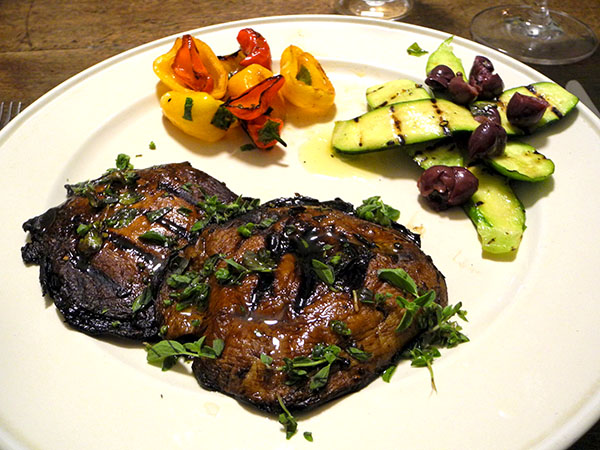We had returned from Rhode Island the night before, where we had been immersed in locavore creative cookery, so my visit to the Union Square Greenmarket the next day was even more burdened with the weight of responsibility than usual.
I should have been intimidated by the fantastic meals we had enjoyed from the kitchens of Derek Wagner (Nick’s on Broadway, as well as the oyster farm dinner the day before), and Ben Sukle (Birch). In fact I wasn’t, mostly because, after five days away from my own kitchen, I was so anxious to re-visit the bounty of our home counties.
Among the many pleasures we encountered in Rhode Island which were uncommon or unheard of on our New York table, was the appearance, several times, of sweet corn, even more sweet husk cherries, and somewhat sour tiny cucumbers, shaped and colored like watermelons. At the Greenmarket on Saturday my only deliberate purchase, other than the fish, was some corn (a vegetable whose origins are Mexican); the fact that I also brought home husk cherries and sour gherkins (both of Mexican origin) was totally fortuitous. I had no plans to put them together with the maiz, but when I looked on line for ideas for serving corn (off the cob, of course), the first suggestion was to combine it with Physalis pruinosa and the little gherkins, or ‘Sandita‘. It looked like a natural, and I had just the right amount and proportion of each ingredient.
As far as the fish portion of this meal is concerned, while cod is not found in the warmer waters of either the Gulf or the Pacific, there are a number of other white fish in those oceans.
I had also picked up less than two ounces of chantarelle (girolle) mushrooms at the Greenmarket, not knowing until later in the evening what I would do with them (Mexico does have an exact equivalent to the chanterelle mushroom). Mexican cuisine would be more likely to incorporate cilantro than parsley, but I used Italian Parsley here because I had not planned ahead.
My dinner was now fully conceived.
Even the wine had a Mexican connection, the parents of the vintner, Dalia Ceja, were field workers who became the first Mexican-American winery owners in Napa and Carneros.
- a one-pound cod fillet from P.E. & D.D. Seafood, halved, then prepared more or less according to Martha Rose Shulman’s recipe in the New York Times, but I sautéed the cod, and used a rosé wine instead of a white with the mushrooms (to avoid having to open a fresh bottle, and because it was pretty), and I used a knife, mortar and pestle in making the parsley sauce; the mushrooms were from Violet Hill Farm, the garlic from Berried Treasures, and the parsley from Tamarack Hollow Farm
- three small ears of bi-colored corn from Sycamore Farms, pan-grilled, cut off of the cobs, mixed with husk cherries from Tamarack Hollow Farm, and halved tiny Mexican gherkins, or ‘Sandita’, from Norwich Meadows Farm, tossed with a vinaigrette composed of olive oil, lemon juice, torn leaves off of a Full Bloom Market Garden basil plant from Whole Foods, excellent cayenne from Spices and Tease in Chelsea Market, salt, and ground black pepper
- the wine was a California white, La Tapatia Chardonnay Carneros 2013 by Dalia Ceja
- the music was Antoine Dauvergne’s Hercule Mourant
[lower image, by Franz Eugen Köhler, from Köhler’s Medizinal-Pflanzen, in Wikipedia]














